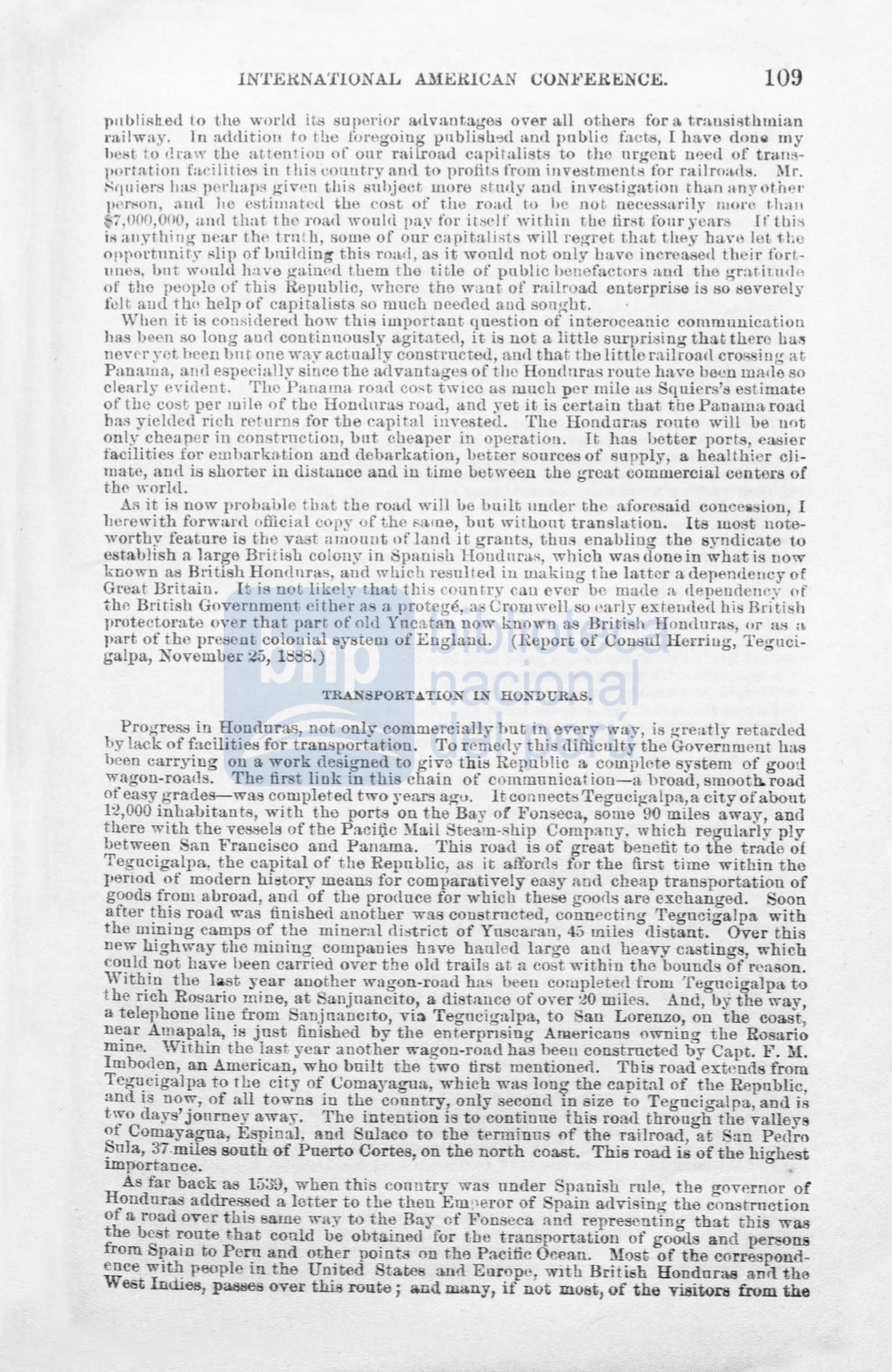

IN'l'E~NA'l'lONAL
A.M.BRWAN
CON~'ERENGE.
109
flllblish.edto the world it· superior adva.nta.ges over all others fora tmusisthmian
railway.ln adclition
to
tbe foregoiug published anfl pnblic facts, I have
don~
my
ht:>RL
to
draw
the attflntion of onr railroad capital ists to tho nrgent
n~ed
of tn.uts–
portation
f;wi
1
itie.'i in this conutry and to profits from investments for railroacl ·. Mr.
:-;qniers
ha~
pcrhaps
¡!Ívc·n
tbis suhjeet more stwly aml invcstigation than
an y othP.r
pPr~<on,
an(l
l1e ('stímatcü the cost of the
ro<~Ü
to
ue
no tnecessaríly
moro t.han
$7,000,000,
an<l that
tbe
TOatl
WOUIÜ pa,V
for Ít>.lelf within
ti.Jefirst tonryears
ff
tbi;¡
ili
anytbing
ncar thn trntl1, sorne of our capitalir,;t · will r
egret that they haYo let t,l:e
opportlmit~·
l'lip of u1tilding this road, as it would not only
lH1VO
increase<l the ir for t–
Hnes.
bnt
wonld h:lVe g;aiued them the title of pu!Jlic benefactor aml the gratirnd e
of the pcople of this Repnblic, whcre tbe waut. of milroad enterprise is so severely
fol t aU<l thP help of capitalista o much needed aod songbt.
Wben it is consicleretl how this important qnestion of interoceanic communicatiou
has been so long aud continnonsly agitated, it is not a little snrprising that tbf're
llal!
neY<'r
yet
heen unt one way actual!y constructe<l, ancl that the littlo railroarl cro8 iog at
Panama, and especial!? since the aclvantagcs of ti!
e
Hondnras route have beun
m
acle so
clearly e\'ident. Thc Panama road
co~t
twicc
a
mnch per mile as
Squiers'~.>
estímate
of tbe cost per
mil
e
of
tbe Hon<lnras road, and
~'et
it
is certain tbat tbe Pauama road
has yiehle<l rich rí'turns for tbe capital investecL The Honduras routo will be ul)t
only ehea per in constrnctiou, but cbeaper in operation.
It
has uotter ports, easier
facil ities for emharkatiou and debarkation, IJetter sources of supply, a health¡or cli–
ma
te,
antl
is
shorter in distance an<l in t ime betweeu tbe great commercial centers of
t h<> world.
As it is now probabl e tha the road will ue built 1mder tbo aforesaid conce¡sion, I
ueren-ith
forw~u·d
üllicia l copy of t
he ¡:;ame, but withont translation.
Its wost uote–
wortby featnre is tbe va
t
awount
nfla.ndi t grants, t hus ena!Jling tbe syndicate to
establish a 1arge British colony in
8panishllomlnra:-., which was done in wbat is uow
kuown as Bl'itish Honduras, and which resnlteü in making the lattcr a dependency of
Great 13ritain.
[t
is not likely that thi · rountry can evcr be mude a. flepeude11cy of
the British Government eitber as a protegé, as Croruwell so Pariy extended bis British
protectorate over that part of olJ Yncatan now known as British Honduras, or a
a
part of the present colonial system of :England..
(Heport of Consul Herring, Teguci–
galpa, November 25,
1&38.)
TRANSPORT.A.TION
L."'{
HONDURAS.
Progresa in Honduras, not only commercially hut in every way, is greatly retarded
y lack of facilities for t ransportatiou. To remedy thi difficulty tbe Government has
been carrying on a work designed to give this Republie a complote system of gootl
wa.gon-roads. The first link in this chain of commnuicat ion- a broad,
smoot~
road
of easy grades- was corupleted two years agu. Uconnects
Teguci~alpa,a
city ofabout
1~,000
inha.bitants, with the
ports on the Bay of Pon eca., sorne 90 miles away, and
there with the vessels of the
Pa.ci:l;lc
~[ail
Steam-ship Company, which
re~ularly
ply
between
an Francisco and
Panama. This 1·oad is of great benetit to tne trade of
Tegucigalpa, tbe capital of the Repnblic, as
it
alfords for the ürst time within the
period of modern hi8tory meaus for compara.tively easy and cheap transportation of
goods from abroad, and of tbe produce for which the.,e gooc1s are excbanged. Soon
after this road was fi.nished another was constructed, connecting Tegucigalpa. with
the mining camps of the mineral district of Ynscaran,
45 mile~:~
distant. Over this
new highway the miuing corupanies
h~ve
hauled la.rge
a.ndheavy casting , which
could not have heen carried over the old trails a.t a cost
within the bonnd of reason.
,,.ith_in the last year another wagon-road ha ueeu corupleted from Tegucigalpa to
t be nch Rosario mine, at Sanjnancito, a di tance of over
:tO
míie.. And, by the way,
a telephone line from Sanjnan01to, vi:) Tegucigalpa, to
an Lorenzo, on the coast,
n~ar Am~pa~a,
ÍM
just fini becl by the enterpnsiug Americans owning the Rosario
mme.
\Vtthm the last ycar another wagon-road has been constructed by Capt. P. M.
lmboden, an American, wbo built the two tirst mentionerl. Tbis road extends from
Tcgu_cigalpa to t he city of Comayagua, which wa
Ion~
the capital of the Repnblic
aud
1s
now, of all towns in the country, only seconrl m
ize
to
Tegucigalpa, and is
h:o days' jonrney a.way. The inteution is to continne this road through the valleys
of Comayagna, Espinal. and Sulaco to the terminu of the rai1road, at
an Pedro
~nla,
37.miles south of Puerto Cortes, on the north coast. This road is of the highest
unportance.
As far back a
15:39, when this country was under Spanish rule the governor of
Honduras addressed a letter to the then Em:,eror of Spaiu advi ing the con trnction
of a road over this ame way to the Bay of }'onscca and representing that this was
the b cst
~oute
that could be obtained for tbe transportatiou of goods and person.s
from Sf?aiD to P er_u and other poiuts on the Pacitic Ocean. Most of the corre poud–
cnce
w1~
people m tbe United State and Europe, with British Honduras anrl th
Weot lnd.les, pa.sses over this route; and mauy, if not most, of the visitors from the
















